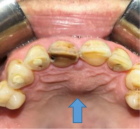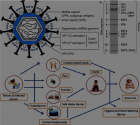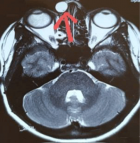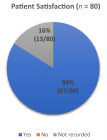Abstract
Research Article
Prevalence of reported drug allergy and its impact on Beta lactam use with financial and health implications
Joanna Lukawska*, Abirami Murugesh-Warre#, Ranu Malhin#, Yogini Jani, Christopher Corrigan, David Walker and Harsha Kariyawasam
Published: 22 August, 2017 | Volume 1 - Issue 1 | Pages: 028-035
Background:While recognition and documentation of true drug allergy is critically important, most physicians acknowledge that its prevalence is likely overestimated, often on the basis of historical, sometimes anecdotal evidence. Correct or not, once applied, drug allergy labels may result in altered, potentially inferior therapy, increased costs and prolonged hospitalisation.
Objective:Estimate the point prevalence, accuracy and symptomatology of self-reported drug allergy in a typical, large NHS Acute Trust adult inpatient population. In the subset with penicillin allergy (PA), estimate additional management costs from the use of alternative antibiotics and readmission rates in the previous 5 years.
Methods:Data on self-reported drug allergies were extracted from 440 adult inpatient prescription charts over a 4 month period. Where penicillin allergy (PA) was reported, alternative antibiotic regimens were recorded and their additional costs calculated. Hospital electronic records were used to assess readmission rates of PA patients.
Results:194/440 inpatients (44.5%) reported at least one drug allergy. Antibiotic allergy was most commonly reported (51%), followed by analgesic (23%) and antiemetic (12%) allergy. PA accounted for 76% of reported antibiotic allergy. The commonest reported symptoms were cutaneous (42%) and gastrointestinal (18%). Where antibiotic therapy was required for patients with PA to manage acute infections, Ciprofloxacin, Clarithromycin, Teicoplanin, Clindamycin and Cefuroxime were the most commonly employed alternatives. Extrapolation of these figures to include the entire Trust inpatient population suggested that the use of alternative antibiotics in PA patients incurred additional annual expenditure of £268,000. Further, 87% of PA patients had been admitted more than once in the preceding 5 years, with 74% requiring further courses of antibiotics during these admissions.
Conclusion:Self-reported drug allergy, and in particular PA, is common in hospital inpatient populations and, in addition to the potentially unnecessary hazards to individual patients resulting from the use of alternative antibiotics, results in a considerable additional financial burden to the healthcare system. This problem could be eliminated by the provision of a nationwide and equitable tertiary Allergy service.
Read Full Article HTML DOI: 10.29328/journal.haard.1001004 Cite this Article Read Full Article PDF
Keywords:
Penicillin; Beta lactams; Allergy; Antibiotic; Cost; Readmission; Self-reported; Drug allergy
References
- Bigby M. Rates of cutaneous reactions to drugs. Arch Dermatol. 2001; 137: 765-770. Ref.: https://goo.gl/NSJVU3
- Classen DC, Pestonik SL, Evans RS, Burke JP. Computerized surveillance of adverse drug events in hospitalized patients. JAMA. 1991; 266: 2847-2851. Ref.: https://goo.gl/GV1cBb
- Rademaker M, Oakley A, Dufill MB. Cutaneous adverse drug reactions in a hospital setting. N Z Med J. 1995; 108: 165-166. Ref.: https://goo.gl/86CLgx
- Hunziker T, Kunzi UP, Braunschweig S, Zehnder D, Hoigne R. Comprehensive hospital drug monitoring (CHDM): adverse skin reactions, a 20-year survery. Allergy. 1997; 52: 388-393. Ref.: https://goo.gl/yNG1GA
- Sharma VK, Sethuraman G, Kumar B. Cutaneous adverse drug reactions: clinical pattern and causative agents- a 6 year series from Chandigarh, India. J Postgrad Med. 2001; 47: 388-393. Ref.: https://goo.gl/cyzFfa
- Thong BY, Leong KP, Tang CY, Chng HH. Drug Allergy in a general hospital: results of a novel prospective inpatient reporting system. Ann Allergy Asthma Immunol. 2003; 90: 342-347. Ref.: https://goo.gl/nyjuSv
- Fiszenson-Albala F, Auzerie V, Mahe E, Farinotti R, Durand-Stocco C, et al. A 6-month prospective survey of cutaneous drug reactions in a hospital setting. Br J Dermatol. 2003; 149: 1018-1022. Ref.: https://goo.gl/Lg23pk
- Hernández-Salazar A, Rosales SP, Rangel-Frausto S, Criollo E, Archer-Dubon C, et al. Epidemiology of adverse cutaneous drug reactions. A prospective study in hospitalized patients. Arch Med Res. 2006; 37: 899-902. Ref.: https://goo.gl/eKT2So
- Macy E, Contreras R. Healthcare use of serious infection prevalence associated with penicillin ‘allergy’ in hospitalized patients: a cohort study. J Allergy Clin Immunol. 2014; 133: 790-796. Ref.: https://goo.gl/NyVNQC
- Park MA, Matesic D, Markus PJ, Li JTC. Female sex as a risk factor for penicillin allergy. Ann Allergy Asthma Immunol. 2007; 99: 54-58. Ref.: https://goo.gl/udaN4i
- Vander Stichele RH, Elseviers MM, Ferech M, Blot S, Goossens H. Hospital consumption of antibiotics in 15 European counties: results of the ESAC Retrospective Data Collection (1997-2002). J Antimicrob Chemother. 2006; 58: 159-167.
- Pumphrey RS, Davis S. Under-reporting of antibiotic anaphylaxis may put patients at risk. Lancet. 1999; 353: 1157-1158. Ref.: https://goo.gl/2brVZ4
- Tunkel AR, Hartman BJ, Kaplan SL, Kaufman BA, Roos KL, et al. Practice guidelines for the management of bacterial meningitis. Clin Infect Dis. 2004; 39: 1267-1284. Ref.: https://goo.gl/k85jz5
- Dellinger RP, Levy MM, Rhodes A, Annane D, Gerlach H, et al. Surviving sepsis campaign: international guidelines for management of severe sepsis and septic shock. Crit Care Med. 2013; 41: 580-637. Ref.: https://goo.gl/D8hdSK
- Solomkin JS, Mazuski JE, Bradley JS, Rodvold KA, Goldstein EJ, et al. Diagnosis and management of complicated intra-abdominal infection in adults and children: guidelines by the Surgical Infection Society and the Infectious Diseases Society of America. Clin Infect Dis. 2010; 50: 133-164. Ref.: https://goo.gl/wSDsPS
- American Thoracic Society, Infectious Diseases Society of America. Guidelines for the management of adults with hospital-acquired, ventilator-associated, and healthcare-associated pneumonia. Am J Respir Crit Care Med. 2005; 171: 388-416. Ref.: https://goo.gl/A1fbvv
- Lipsky BA, Berendt AR, Cornia PB, Pile JC, Peters EJ, et al. 2012 Infectious Diseases Society of America clinical practice guideline for the diagnosis and treatment of diabetic foot infectious. Clin Infect Dis. 2012; 54: 132-173. Ref.: https://goo.gl/bDchcc
- Stevens DL, Bisno AL, Chambers HF, Dellinger EP, Goldstein EJ, et al. Practice guidelines for the diagnosis and management of skin and soft tissue infections: 2014 update by the Infectious Disease Society of America. Clin Infect Dis. 2014; 59: 10-52. Ref.: https://goo.gl/d7JXf3
- Jeffries MN, Narayan PP, Shuster JE, Schramm GE. Consequences of avoiding beta-lactams in patients with b-lactam allergies. J Allergy Clin Immunol. 2016; 137: 1148-1153. Ref.: https://goo.gl/G2euqr
- Picard M, Begin P, Bouchard H, Cloutier J, Lacombe-Barrios J, et al. Treatment of patients with a history of penicillin allergy in a large tertiary-care academic hospital. J Allergy Clin Immunol Pract. 2013; 1: 252-257. Ref.: https://goo.gl/ycXTQp
- Li M, Krishna MT, Razaq S, Pillay D. A real-time prospective evaluation of clinical pharmaco-economic impact of diagnostic label of ‘penicillin allergy’ in a UK teaching hospital. J Clin Pathol. 2014; 67: 1088-1092. Ref.: https://goo.gl/qPVd68
- NHS Business Services Authority, NHS Prescription Services. NHS Electronic Drug Tariff. [Internet]. nhsbsa.nhs.uk
- British National Formulary. [Internet]. medicinescomplete.com. [Cited October 5, 2016]. Ref.: https://goo.gl/GmWRHa
- Gomes E, Cardoso MF, Praça F, Gomes L, Mariño E. Self-reported drug allergy in a general adult Portugese population. Clin Exp Allergy. 2004; 34: 1597-1601. Ref.: https://goo.gl/eBQG5p
- MacPherson RD, Willcox C, Chow C, Wang A. Anaesthetist’s responses to patients’ self-reported drug allergies. Br J Anaesth. 2006; 97: 634-639. Ref.: https://goo.gl/XV3AFL
- Jones TA, Como JA. Assesment of medication errors that involved drug allergies at a university hospital. Pharmacotherapy. 2003; 23: 855-860. Ref.: https://goo.gl/UbQHhH
- Shenfield GM, Robb T, Duguid M. Recording previous adverse drug reactions-a gap in the system. Br J Clin Pharmacol. 2001; 51: 623-626. Ref.: https://goo.gl/gw7xJk
- Gadde J, Spence M, Wheeler B, Adkinson NF Jr. Clinical experience with penicillin skin testing in a large inner-city STD clinic. JAMA. 1993; 270: 2456-2463. Ref.: https://goo.gl/1JvTvT
- Solensky R. Hypersensitivity reactions to beta-lactam antibiotics. Clin Revi Allerg Immu. 2003; 24: 201-220. Ref.: https://goo.gl/CGjKqb
- Macy E, Poon KY T. Self-reported antibiotic allergy incidence and prevalence: age and sex effects. Am J Med. 2009; 122: 1-7. Ref.: https://goo.gl/948w46
- Joint Task Force on Practice Parameters, American Academy of Alergy, Asthma and Immunology, American College of Allergy, Asthma and Immunology, Joint Council of Allergy, Asthma and Immunology. Drug allergy: an updated practice parameter. Ann Allergy Asthma Immunol. 2010; 105: 259-273.
- Shah NS, Ridgway JP, Pettit N, Fahrenbach J, Robicsek A. Documenting Penicillin Allergy: The Impact of Inconsistency. PLoS ONE. 2016; 11: e0150514. Ref.: https://goo.gl/mScXJD
- Macy E. How predictive is a history of penicillin allergy? JAMA. 2001; 286: 1174. Ref.: https://goo.gl/XxBMXj
- Wong BB, Keith PK, Waserman S. Clinical history as a predictor of penicillin skin test outcome. Ann Allergy Asthma Immunol. 2006; 97: 169-174. Ref.: https://goo.gl/HRcFRo
- Rubio M, Bousquiet PJ, Gomes E, Romano A, Demoly P. Results of d drug hypersensitivity evaluations in a large group of children and adults. Clin Exp Allergy. 2011; 42: 122-123. Ref.: https://goo.gl/Gju6Ns
- Hensgens MP, Goorhuis A, Dekkers OM, Kuijper EJ. Time interval of increased risk of Clostridium difficile infection after exposure to antibiotics. J Antimicrob Chemoth. 2012; 67: 742-748. Ref.: https://goo.gl/y1ifMy
- Weiss K. Clostridium difficile and fluoroquinolones: is there a link? Int J Antimicrob Agents. 2009; 33: 29-32. Ref.: https://goo.gl/DiAJ9g
- NHS Confederation. Key Statistics on the NHS. [Internet]. NHS confederation org. 2016 [cited on July 17, 2016]. Available from: Ref.: https://goo.gl/ZiqSQL
- Canadian Medical Association. Physician Data Centre: Canadian physician statistics. [Internet]. Canadian Medical Association. 2016 [cited July 17, 2010]. Ref.: https://goo.gl/EkY6UK
- Balekian DS, Banerji A, Blumenthal KG, Camargo CA, Long AA. Allergen immunotherapy: No evidence of infectious risk. J Allergy Clin Immunol. 2016; 137: 1887-1888. Ref.: https://goo.gl/s4oRqA
Figures:

Figure 1

Figure 2
Similar Articles
-
Prevalence of reported drug allergy and its impact on Beta lactam use with financial and health implicationsJoanna Lukawska*,Abirami Murugesh-Warre#,Ranu Malhin#,Yogini Jani,Christopher Corrigan,David Walker,Harsha Kariyawasam. Prevalence of reported drug allergy and its impact on Beta lactam use with financial and health implications. . 2017 doi: 10.29328/journal.haard.1001004; 1: 028-035
-
Allergic Asthma and Sick building syndromeSeyyed Shamsadin Athari*. Allergic Asthma and Sick building syndrome . . 2019 doi: 10.29328/journal.aaai.1001015; 3: 001-002
-
Biologic therapy in severe asthma: An updateMaha A Al Ammari*. Biologic therapy in severe asthma: An update. . 2019 doi: 10.29328/journal.aaai.1001016; 3: 003-009
-
Higher venom-specific IgE levels differentiate children with previous local large reactions from children with previous systemic reactions of different severityPastorello Elide Anna*,Borgonovo Linda,Piantanida Marta,Schroeder Jan Walter,Pravettoni Valerio,Pastori Stefano,Bilo’ Maria Beatrice,Toniato Andrea,Aversano Maria Gloria,Farioli Laura,Nichelatti Michele,Preziosi Donatella. Higher venom-specific IgE levels differentiate children with previous local large reactions from children with previous systemic reactions of different severity. . 2021 doi: 10.29328/journal.aaai.1001025; 5: 017-021
-
An algorithm to safely manage oral food challenge in an office-based setting for children with multiple food allergiesNathalie Cottel,Aïcha Dieme,Véronique Orcel,Yannick Chantran,Mélisande Bourgoin-Heck,Jocelyne Just. An algorithm to safely manage oral food challenge in an office-based setting for children with multiple food allergies. . 2021 doi: 10.29328/journal.aaai.1001027; 5: 030-037
-
Treatment protocol with alternative iron drugs in patients with an allergic reaction during iron replacement therapySaltuk Buğra Kaya*. Treatment protocol with alternative iron drugs in patients with an allergic reaction during iron replacement therapy. . 2023 doi: 10.29328/journal.aaai.1001030; 7: 001-004
-
Effectiveness of levocetirizine in treating allergic rhinitis while retaining work efficiencyDabholkar Yogesh, Shah Tanush, Rathod Roheet, Paspulate Akhila, Veligandla Krishna Chaitanya, Rathod Rahul, Devesh Kumar Joshi*, Kotak Bhavesh. Effectiveness of levocetirizine in treating allergic rhinitis while retaining work efficiency. . 2023 doi: 10.29328/journal.aaai.1001031; 7: 005-011
-
Impact of Latex Sensitization on Asthma and Rhinitis Progression: A Study at Abidjan-Cocody University Hospital - Côte d’Ivoire (Progression of Asthma and Rhinitis related to Latex Sensitization)Dasse Sery Romuald*, KL Siransy, N Koffi, RO Yeboah, EK Nguessan, HA Adou, VP Goran-Kouacou, AU Assi, JY Seri, S Moussa, D Oura, CL Memel, H Koya, E Atoukoula. Impact of Latex Sensitization on Asthma and Rhinitis Progression: A Study at Abidjan-Cocody University Hospital - Côte d’Ivoire (Progression of Asthma and Rhinitis related to Latex Sensitization). . 2024 doi: 10.29328/journal.aaai.1001035; 8: 007-012
Recently Viewed
-
Prediction of neonatal and maternal index based on development and population indicators: a global ecological studySedigheh Abdollahpour,Hamid Heidarian Miri,Talat Khadivzadeh*. Prediction of neonatal and maternal index based on development and population indicators: a global ecological study. Clin J Obstet Gynecol. 2021: doi: 10.29328/journal.cjog.1001096; 4: 101-105
-
A Genetic study in assisted reproduction and the risk of congenital anomaliesKaparelioti Chrysoula,Koniari Eleni*,Efthymiou Vasiliki,Loutradis Dimitrios,Chrousos George,Fryssira Eleni. A Genetic study in assisted reproduction and the risk of congenital anomalies. Clin J Obstet Gynecol. 2021: doi: 10.29328/journal.cjog.1001095; 4: 096-100
-
Leiomyosarcoma in pregnancy: Incidental finding during routine caesarean sectionToon Wen Tang*,Phoon Wai Leng Jessie. Leiomyosarcoma in pregnancy: Incidental finding during routine caesarean section. Clin J Obstet Gynecol. 2021: doi: 10.29328/journal.cjog.1001094; 4: 092-095
-
Adult Neurogenesis: A Review of Current Perspectives and Implications for Neuroscience ResearchAlex, Gideon S*,Olanrewaju Oluwaseun Oke,Joy Wilberforce Ekokojde,Tolulope Judah Gbayisomore,Martina C. Anene-Ogbe,Farounbi Glory,Joshua Ayodele Yusuf. Adult Neurogenesis: A Review of Current Perspectives and Implications for Neuroscience Research. J Neurosci Neurol Disord. 2024: doi: 10.29328/journal.jnnd.1001102; 8: 106-114
-
Late discover of a traumatic cardiac injury: Case reportBenlafqih C,Bouhdadi H*,Bakkali A,Rhissassi J,Sayah R,Laaroussi M. Late discover of a traumatic cardiac injury: Case report. J Cardiol Cardiovasc Med. 2019: doi: 10.29328/journal.jccm.1001048; 4: 100-102
Most Viewed
-
Evaluation of Biostimulants Based on Recovered Protein Hydrolysates from Animal By-products as Plant Growth EnhancersH Pérez-Aguilar*, M Lacruz-Asaro, F Arán-Ais. Evaluation of Biostimulants Based on Recovered Protein Hydrolysates from Animal By-products as Plant Growth Enhancers. J Plant Sci Phytopathol. 2023 doi: 10.29328/journal.jpsp.1001104; 7: 042-047
-
Sinonasal Myxoma Extending into the Orbit in a 4-Year Old: A Case PresentationJulian A Purrinos*, Ramzi Younis. Sinonasal Myxoma Extending into the Orbit in a 4-Year Old: A Case Presentation. Arch Case Rep. 2024 doi: 10.29328/journal.acr.1001099; 8: 075-077
-
Feasibility study of magnetic sensing for detecting single-neuron action potentialsDenis Tonini,Kai Wu,Renata Saha,Jian-Ping Wang*. Feasibility study of magnetic sensing for detecting single-neuron action potentials. Ann Biomed Sci Eng. 2022 doi: 10.29328/journal.abse.1001018; 6: 019-029
-
Pediatric Dysgerminoma: Unveiling a Rare Ovarian TumorFaten Limaiem*, Khalil Saffar, Ahmed Halouani. Pediatric Dysgerminoma: Unveiling a Rare Ovarian Tumor. Arch Case Rep. 2024 doi: 10.29328/journal.acr.1001087; 8: 010-013
-
Physical activity can change the physiological and psychological circumstances during COVID-19 pandemic: A narrative reviewKhashayar Maroufi*. Physical activity can change the physiological and psychological circumstances during COVID-19 pandemic: A narrative review. J Sports Med Ther. 2021 doi: 10.29328/journal.jsmt.1001051; 6: 001-007

HSPI: We're glad you're here. Please click "create a new Query" if you are a new visitor to our website and need further information from us.
If you are already a member of our network and need to keep track of any developments regarding a question you have already submitted, click "take me to my Query."


















































































































































